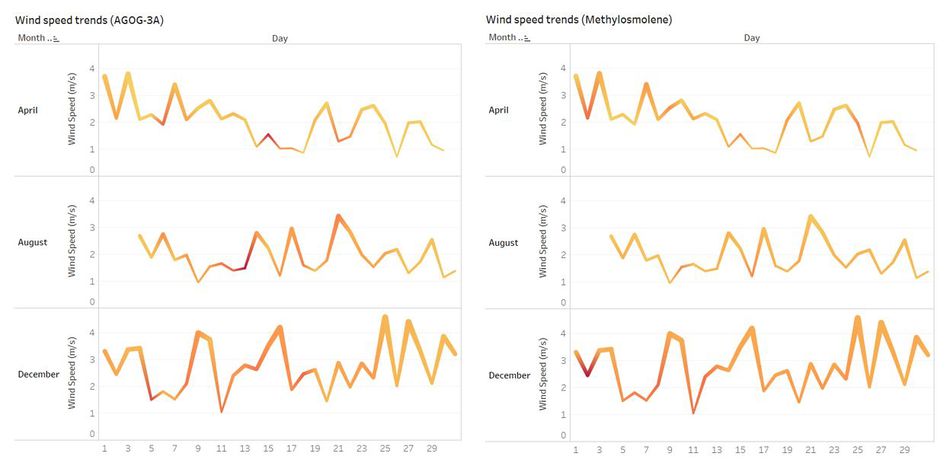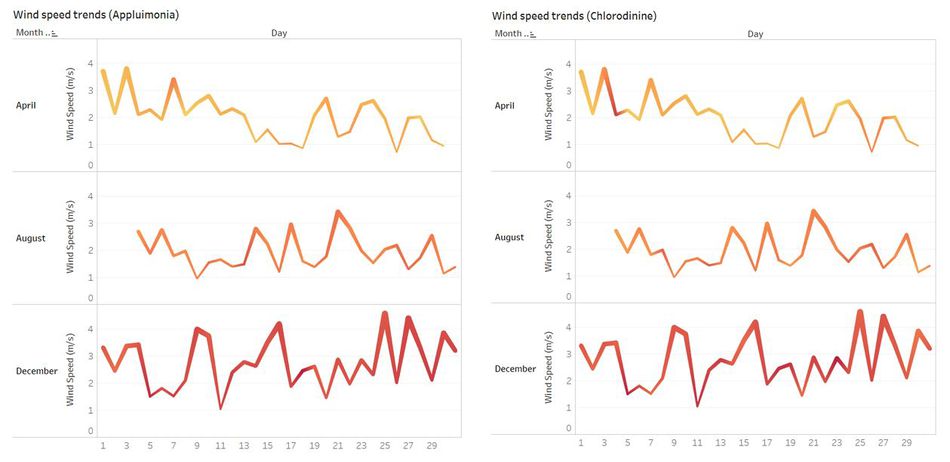Difference between revisions of "Q3"
| Line 40: | Line 40: | ||
1. AGOG- 3A: | 1. AGOG- 3A: | ||
<br/> | <br/> | ||
| − | In July, high amount of AGOG-3A | + | In July, when the wind speed was low, the sensors were able to capture AGOG-3A release; Hence the high amount of AGOG-3A release on the two days is due to the wind speed being low and on the other days since the wind speed was high, the chemical readings captured is low. |
<br/> | <br/> | ||
In August, 13th experienced a high reading of this chemical , and all the peak wind speed days experienced above average AGOG -3A release. | In August, 13th experienced a high reading of this chemical , and all the peak wind speed days experienced above average AGOG -3A release. | ||
<br/> | <br/> | ||
| − | In December, above average release of AGOG-3A is uniformly observed throughout the month. | + | In December, above average release of AGOG-3A is uniformly observed throughout the month. Hence we can that the reason for not seeing high AGOG-3A value is because of the wind speed. |
<br/> | <br/> | ||
2. METHYLOSMOLENE: | 2. METHYLOSMOLENE: | ||
<br/> | <br/> | ||
| − | + | July and August have relatively low reading and the wind speed has no impact on the release of Methylosmolene. | |
<br/> | <br/> | ||
In December, it is observed that on the days of low wind speed, the release of Methylosmolene is high when compared to the days with high wind speed. | In December, it is observed that on the days of low wind speed, the release of Methylosmolene is high when compared to the days with high wind speed. | ||
<br/> | <br/> | ||
[[File:Sumalika_Q3P2part2.JPG|950px|right|float]] | [[File:Sumalika_Q3P2part2.JPG|950px|right|float]] | ||
| − | |||
| − | |||
3. APPLUIMONIA: | 3. APPLUIMONIA: | ||
<br/> | <br/> | ||
Compared to three months, December shows high release of Appluimonia throughout independent of the speed of the wind. | Compared to three months, December shows high release of Appluimonia throughout independent of the speed of the wind. | ||
Revision as of 14:04, 13 July 2017
|
|
|
|
|
|
WIND SPEED TRENDS:
Wind speed analysis is done to understand the speed of the wind for each month and identify the day that experienced a lot of chemical release due to the wind speed. The charts shown describe the wind speed for each chemical released on a particular day. The color refers to the average reading of chemical and the thickness of the lines represent the wind speed intensity.
There is no wind data available from 1st August to 3rd August. So the findings are based on rest of the days in July, August and December.
Wind speed trends for each chemical:
1. AGOG- 3A:
In July, when the wind speed was low, the sensors were able to capture AGOG-3A release; Hence the high amount of AGOG-3A release on the two days is due to the wind speed being low and on the other days since the wind speed was high, the chemical readings captured is low.
In August, 13th experienced a high reading of this chemical , and all the peak wind speed days experienced above average AGOG -3A release.
In December, above average release of AGOG-3A is uniformly observed throughout the month. Hence we can that the reason for not seeing high AGOG-3A value is because of the wind speed.
2. METHYLOSMOLENE:
July and August have relatively low reading and the wind speed has no impact on the release of Methylosmolene.
In December, it is observed that on the days of low wind speed, the release of Methylosmolene is high when compared to the days with high wind speed.
3. APPLUIMONIA:
Compared to three months, December shows high release of Appluimonia throughout independent of the speed of the wind.


